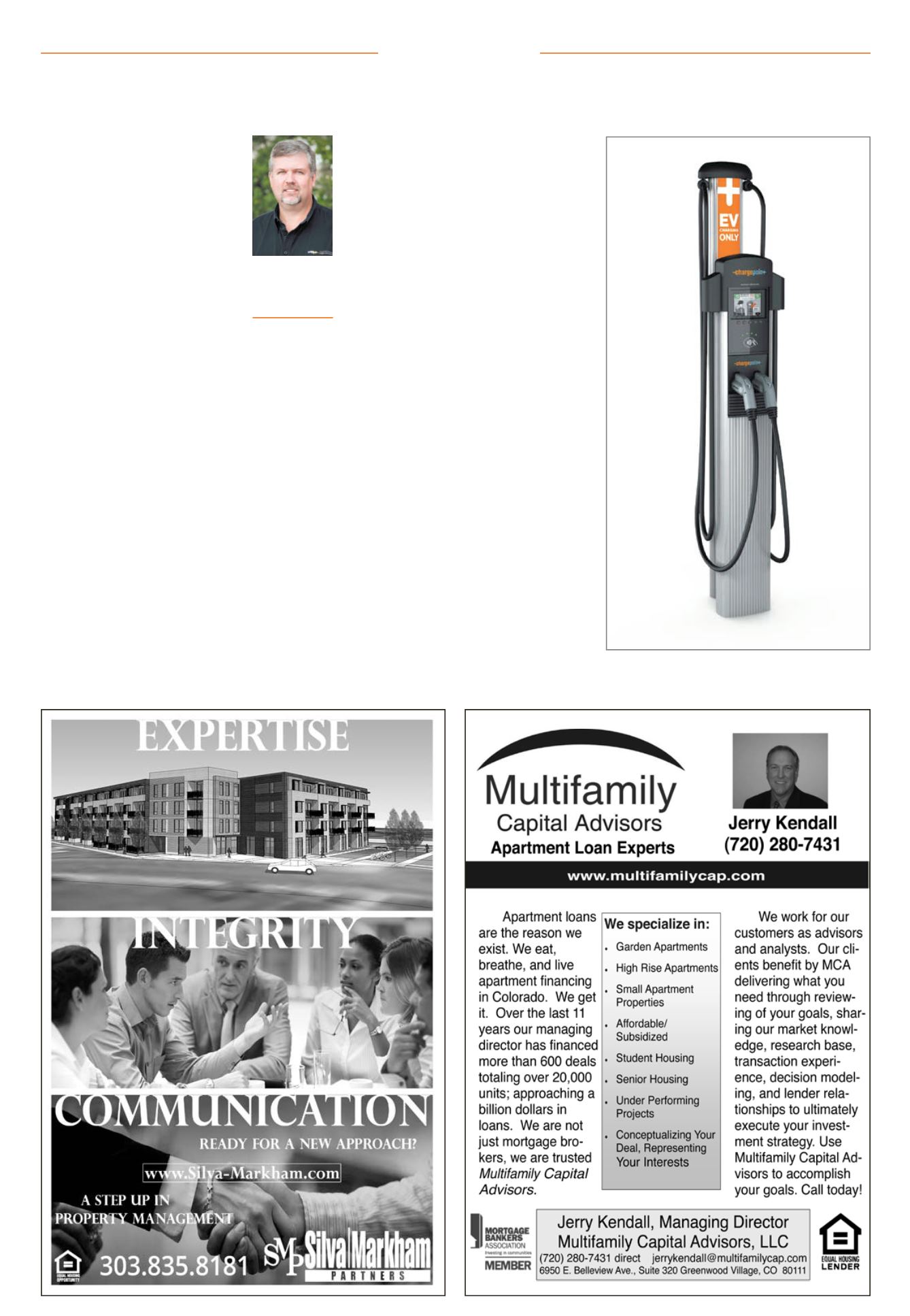

April 2015 — Multifamily Properties Quarterly —
Page 19
M
ore properties around the
country are receiving calls
from prospective tenants
looking for the ability to
plug in their electric cars.
For these renters, there is no middle
ground. Either they can move in or
they have to look elsewhere, and
many property owners are quickly
realizing that offering electric vehi-
cle charging is a powerful recruit-
ment and retention tool. EV drivers
also generally have higher incomes
and more education, so this group
makes attractive tenants.
While the EV market is still young,
it is developing fast. Plug-in cars
already make up almost 1 percent of
all new cars sold nationwide (3 per-
cent in California), and this number
is predicted to increase to 20 percent
by 2020, according to dmv.com. And
EV drivers love their cars. A recent
PlugInsights study found that over
96 percent of EV owners said they
never want go back to a gas car. As a
result, EV charging is quickly becom-
ing the next must-have amenity for
rental properties, and offers a return
on investment that can be more
powerful than a swimming pool or
exercise room. In fact, a recent study
from Multifamily Executive Maga-
zine found that 17 percent of all
renters want to buy or lease an elec-
tric car in the next five years.
So now you decide that your prop-
erty needs to stay competitive and
add EV charging, and you get a call
with an offer from a service provider
that sounds too good to be true. “Just
lease us the space and we will put
a charging station in for free,” he
says. Why wouldn’t you want to let
someone else pay
for and manage a
charging station on
your property? The
offer is compelling
– no upfront invest-
ment in hardware,
no maintenance
fees and no day-to-
day management
of a new technol-
ogy. The thought of
being completely
hands-off sounds
pretty good.
But, as we all
know, nothing in life truly is free.
In this case, the group who ends up
paying is the drivers, and the cost is
higher than it needs to be because
there is a need to provide a profit to
a third party.
While the EV charging industry is
only four years old, there is enough
data to know a station must be free
or low cost in order for it to be used
regularly, and this is exactly where
the logic breakdown occurs with
third-party-owned stations. As a
property manager, your motivation
is to provide an attractive amenity,
but third-party stations have a dif-
ferent motivation. They cannot
benefit from tenant recruitment or
retention. Their business is to make
money on the resale of electricity.
The largest third-party network
today charges as much as four to
five times the cost of electricity (in
some markets), and can be as high
as the equivalent of $6.50 per gal-
lon of gas. EV drivers are engaged
consumers, usually understanding
the cost-benefit analysis of electric-
ity versus gasoline, and
they refuse to pay such
rates. One of the prima-
ry reasons EV buyers
choose to drive electric
is for economic reasons
and a high fee wipes
out that motivation.
In fact, the same com-
pany recently raised
their rates and drivers
are setting social media
ablaze, saying they are
done patronizing those
stations and the estab-
lishments that host
them. The result? The
company lost $24 mil-
lion last year.
For apartment com-
munities, having an
overpriced charging
station would be the
same as letting a third
party own and operate
an exercise facility in
the building, charging
tenants $50 a month to
use the treadmill. All of
a sudden the amenity
has lost its appeal and
you might as well not
have it at all.
Even worse, over-
priced charging fees
paint the site host as
greedy and unreason-
able, and the driver is
not likely to realize it
is really a third-party
station owner setting
the price. In addition
A free EV charging station? No thanks!Technology
Jim Burness
CEO and general
manager, National
Car Charging,
Denver
Car charging stations are become more common at
multifamily properties.
Please see ‘Tech,’ Page 22















